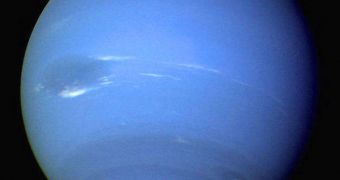Some 234 years before the planet was officially found, Galileo may have made the earliest observations of Neptune, a new study of the famous astronomer's diary and notebooks reveals. Professor David Jamieson, the head of the University of Melbourne School of Physics, made the astonishing claim, after studying in great details the work that Galileo left behind. Details on how to look for the clues in the documents appear in the latest issue of the respected journal Australian Physics, and were also detailed at a UM July Lectures in Physics program last week.
Between the years 1612 and 1613, Galileo ran constant observations on the moons of Jupiter, but kept constantly referring to a faint star somewhere in the same general direction. While this has long been associated with Neptune, computer models have recently revealed for certain that, at the time, the planet would have indeed looked like a faint star precisely in the area where Galileo observed it. If, in the end, it turns out that the Italian astronomer indeed observed Neptune, it would be the first new planet discovered by humans since Antiquity, when most of them were revealed.
“It has been known for several decades that this unknown star was actually the planet Neptune. Computer simulations show the precision of his observations revealing that Neptune would have looked just like a faint star almost exactly where Galileo observed it. But a planet is different to a star because planets orbit the Sun and move through the sky relative to the stars. It is remarkable that on the night of January 28 in 1613 Galileo noted that the 'star' we now know is the planet Neptune appeared to have moved relative to an actual nearby star,” Jamieson says.
Additionally, the researcher shares, some sketches in the notebooks reveal a mysterious black dot on the sky maps, whose position coincides with the correct location of the planet Neptune. “I believe this dot could reveal he went back in his notes to record where he saw Neptune earlier when it was even closer to Jupiter but had not previously attracted his attention because of its unremarkable star-like appearance,” the Australian professor further explains.
“Galileo may indeed have formed the hypothesis that he had seen a new planet which had moved right across the field of view during his observations of Jupiter over the month of January 1613. If this is correct Galileo observed Neptune 234 years before its official discovery. Galileo was in the habit of sending a scrambled sentence, an anagram, to his colleagues to establish his priority for the sensational discoveries he made with his new telescope. He did this when he discovered the phases of Venus and the rings of Saturn. So perhaps somewhere he wrote an as-yet undecoded anagram that reveals he knew he discovered a new planet,” the expert concludes.

 14 DAY TRIAL //
14 DAY TRIAL //